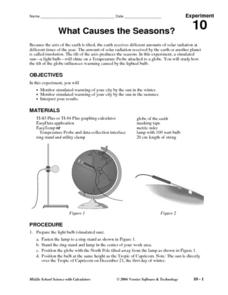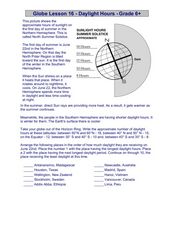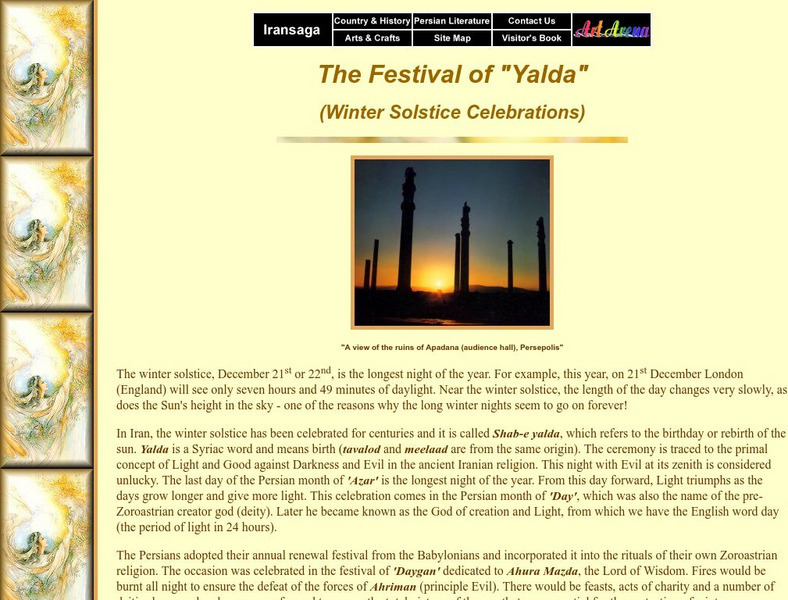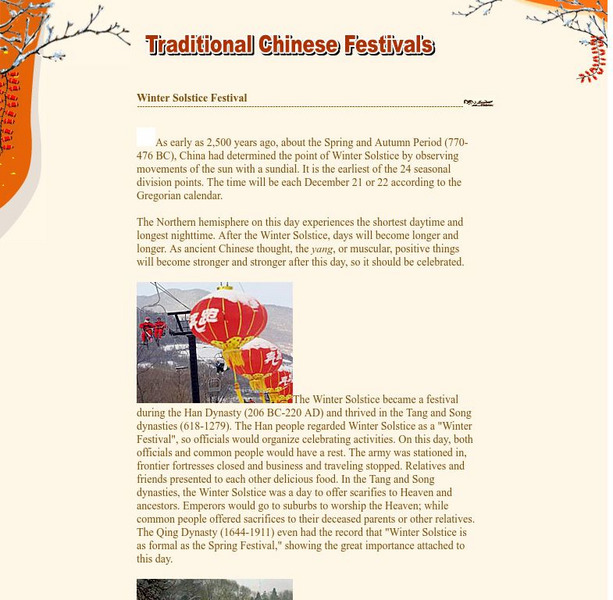Curated OER
How Much Longer is the Day?
In this daylight hours worksheet, students use pictures given to write a number sentence and calculate the answers. This worksheet has 3 word problems.
Curated OER
Working with Sinusoidal Models
In this sinusoidal model instructional activity, students use the sinusoidal model to solve word problems about the hours of daylight in Anchorage, Alaska. Students complete 5 problems.
Curated OER
What Causes the Seasons?
Third graders investigate why the seasons occur throughout the year. They read a traditional wisdom story pertaining to the seasons. They create their own wisdom stories about the seasons and act them out for the class.
Curated OER
Catching Some Rays
Sixth graders explore the tilt of Earth's axis. In this Earth lesson, 6th graders read a Greek mythology story explaining why there are seasons. Students build a sun-ray gathering tool from styrofoam, glue, thermometers, skewers, and...
Curated OER
The Ultimate Guide to December Holidays Around the World
In this holidays around the world worksheet, students answer short answer questions that are celebrated around the world. Students complete 10 short answer questions.
Curated OER
Holiday Exercises
In this interactive holiday worksheet, students view 20 symbols of various holidays and match the correct name of the holiday to the symbol.
Curated OER
Visiting the Arctic Circle
Students familiarize themselves with the Arctic Circle by locating it on a globe and wall map. They discuss they climate in the North Pole and the reasons for its low temperatures. They compare and contrast the climates of the Arctic...
Curated OER
Stargazers And Skywatchers
Young scholars recognize the daily motion of the Sun across the sky, defining the main directions of east, west, south and north. They see how the first calendars were based on changes in the Sun's noontime elevation, and on locations of...
Curated OER
Stargazers and Skywatchers
Students observe the daily motions of the sun and relate them to the functions of a sundial. They determine the locations of sunrises and sunsets and determine how the elevation of the sun effects temperature.
Curated OER
Tracking Sunrise and Sunset
Young scholars collect, record, and graph the sunrise and sunset times. They explain how the relationship between the tilt of Earth's axis and its yearly orbit around the sun produces the seasons.
Curated OER
Navigation
Students study the basic methods for finding one's position on Earth. Latitude can be deduced from the height above the horizon of the pole star or of the noontime Sun, while longitude requires an accurate clock giving universal time.
Curated OER
The Celestial Sphere
High schoolers are introduced to the celestial sphere, describing its apparent rotation and the special role of the pole star.
Curated OER
Seasons in 3D: Student Exploration
In this seasons exploration worksheet, students review vocabulary and answer prior knowledge questions, then use the Seasons in 3D Gizmo to complete exploration activities.
Curated OER
Astronomy With a Stick
Students find the altitude of the Sun at 10 A.M., at solar noon, and at 2 P.M. by measuring the height of the gnomon and the length of the shadow at each time. They record the measurements in their notebooks for later conversion.
Curated OER
Globe Lesson 16 - Daylight Hours
In this geography skills activity, students read an instructional passage regarding daylight hours and then respond to 5 short answer questions.
Curated OER
Length of the Day & the Seasons
Pupils answer questions for each of the graphs and record their answers on the Student Observation Sheet. They use the data they have collected, hypothesize which graph represents which month of the year using each graph. They then...
Curated OER
Properties of Earth: Word Search
In this word search worksheet, students search for words related to the Earth, the sun and it's movements. Terms include seasons, features, and movements.
Other
Earth Sky: Everything You Need to Know: December Solstice 2014
Winter solstice, earliest sunset, latest sunrise. It seems that, in the Northern Hemisphere anyway, these three events should happen on the same day. Read this explanation of the changing of the seasons and learn why the winter solstice...
National Earth Science Teachers Association
Windows to the Universe: The Winter Solstice
Short explanation of the winter solstice, with a diagram. Available in three versions, Elementary, Intermediate, and Advanced. There is also a tab that accesses a Spanish-language version.
Environmental Education for Kids
Eek!: Seasonal Observations: Winter
The shortest day of the year, or the winter solstice, marks the beginning of this season usually occurs around December 21. Bundle up because winter is a fantastic time to track animals and explore the outdoors!
Other
Iransaga: Festival of Yalda, Winter Solstice
Read about the celebration of the winter solstice in Iran. This article tells the history behind the celebration and the traditions that are practiced.
China State Council Information Office and the China International Publishing Group
China Internet Information Center: Winter Solstice Festival
An article about how the winter solstice is celebrated in China.
Other
Lunar and Planetary Institute: Sky Tellers: Myths, Magic, Mysteries of Universe
Very nice website with excellent graphics depicting the change of the seasons and how the seasons are different between the northern and southern hemisphere. Also has a nice informational table of the spring and fall equinox and summer...
Curated OER
China Internet Information Center: Winter Solstice Festival
An article about how the winter solstice is celebrated in China.






















